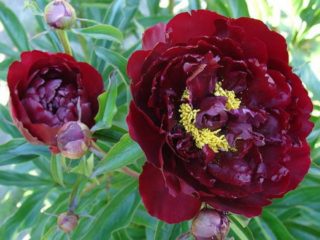Content
Peony thin-leaved Rubra Plena is a herbaceous perennial shrub named after the legendary physician Peon, who healed not only people, but also gods from serious wounds. The plant is ornamental and medicinal. All parts of the culture contain tannins, essential oils, vitamins, minerals and bioflavonoids, and have a tonic, anti-inflammatory, antispasmodic, sedative, anticonvulsant and bactericidal effect.
Description of the herbaceous peony Rubra Plena
Rubra Plena is a hemispherical, thin-leaved double peony with shiny inflorescences of red, ruby or cherry colors. The height of an adult plant varies from 51 to 88 cm. Peony thin-leaved Rubra Plena is formed by rather thick shoots with slight curvature. The leaves are dark green. For peony officinalis Rubra Plena, mid-latitudes with loamy soils with good drainage and high moisture holding capacity are excellent.
The thin-leaved peony Rubra Plena is considered a winter-hardy crop that is not afraid of negative temperatures down to – 41°C. The shrub is light-loving, so sunny places are best suited for it.In the midst of hot summer, the plant should be provided with light partial shade in the hours before and after noon. If you place a thin-leaved peony in an area with abundant shade, it may not bloom or its inflorescences will be very small in size.
Features of flowering
Shoots of the thin-leaved peony Rubra Plena appear already in April, when the soil warms up to a temperature of +6 °C. Over the next month, the upper aerial part is formed, after which buds appear.

The opened bud of Rubra Plena has a spherical or bomb-shaped shape
A glance at it evokes an association with a luxurious double flower, decorated with bright pom-poms. Gradually the petals become lighter. The delicate bud has a pleasant, enchanting and subtle aroma. The first inflorescences can be observed in mid-May; they continue to delight the eye for 14-20 days. They are not afraid of sunlight, are not subject to fading and adhere excellently to bushes.
Application in design

The thin-leaved peony Rubra Plena is actively used in organizing sunny mixborders and rock gardens.
One glance at the photo of the thin-leaved peony Rubra Plena is enough to appreciate the outstanding external characteristics of the culture. The shrub can be planted in almost any area or flower garden.

In design, peony is used to decorate gazebos, paths and other garden elements.

Thin-leaved peony goes well with other representatives of flowering perennials

Neighbors in the flower bed can be irises, clematis, phlox, lilies, tulips and roses
Since the shrub has an early flowering period, it can be planted together with galanthus, crocus and narcissus. Miniature conifers are good neighbors.
Reproduction methods
Peony thin-leaved Rubra Plena is propagated by layering, dividing the bush or cuttings. The optimal time for division is considered to be the period from the second half of August to the beginning of autumn. The shrub is dug up and pruned 10 cm from the root, followed by washing of the root system. A seedling with a couple of buds and a rhizome up to 15 cm in length is suitable for planting. Smaller specimens require additional care, while larger ones have problems with adaptation.
Landing rules
Peony officinalis Rubra Plena does not tolerate proximity to buildings made of stone and brick, large bushes and trees with a spreading crown. The crop is unpretentious to soil, but fertile, loose, slightly acidic soil with high moisture capacity is best suited for it. Sandy soil is considered absolutely unsuitable for the plant. Thin-leaved peony is planted, adhering to the following recommendations:
- The bush is planted in a hole 60 cm wide and deep. The hole is filled with a soil mixture of sand, peat, garden soil and humus, taken in equal parts. The soil needs to be fertilized with superphosphate, bone meal and wood ash.
- When burying the seedling, it is necessary to monitor the buds, which should be located 6 cm below the ground level.
- Between the peony and other plants you need to maintain a distance of about 1 m.
When planting in too clayey soil, sand is added to it; in case of planting in sandy soils, clay is added. Before planting begins, the material requires disinfection for half an hour with a saturated solution of potassium permanganate or garlic infusion. The seedling must be kept in a heteroauxin solution, then dried and the cuts rubbed with charcoal.After completing these manipulations, the seedling is placed in a pre-prepared hole with a sand cushion.

Planting and replanting the fine-leaved peony Rubra Plena is allowed only in the autumn
The culture does not tolerate stagnation of water, which causes rotting of the root system. If there is a high risk of soil freezing, they resort to container growing: seedlings are placed in boxes or barrels. They are kept in flower beds or front gardens throughout the warm season, and with the onset of autumn they are put away in a cellar or a pre-prepared place with comfortable temperature conditions.
Aftercare
Despite the fact that the thin-leaved peony Rubra Plena has strong stems, it needs support in the form of a support. The perennial herbaceous plant does not require special care; regular watering and fertilizing are enough for it. When buds form, as well as during flowering, the soil needs abundant watering (at least 2.5 buckets for each plant). With the onset of spring, the shrub is fed with organic fertilizers, and during the budding period and in mid-autumn, mineral complexes are added.
The soil must be periodically loosened and mulched. Otherwise, the earth will dry out quickly. If the thin-leaved peony Rubra Plena does not want to bloom, you should resort to thinning (removing excess plants from nests and rows to speed up growth rates). At the beginning of flowering, the shrub requires pinching with the removal of side buds that are too small in size. Thanks to this, you can make the inflorescences large and lush.
Humus, horse humus, urea and ammonium nitrate are suitable for feeding the thin-leaved peony Rubra Plena.If the shrub grows on fertile alkaline soil, it practically does not need fertilizing and fertilizers. If the crop develops on poor sandy soil, it needs to be fertilized twice a year. The foliar method is also suitable for feeding young plants: in the second half of May, seedlings are sprayed with a solution of complex mineral soluble fertilizer.
Peony thin-leaved Rubra Plena needs abundant watering during the first weeks after planting in the ground. Watering an adult plant should be rare but plentiful. After watering, the soil in the area around the tree trunk is loosened. Good soil moisture is very important before flowering, as well as during bud formation. It is necessary to monitor the cleanliness of the thin-leaved peony tree trunk by removing weeds and periodically loosening it.
Preparing for winter
Before the onset of cold weather, the shrub requires pruning 6-7 cm above ground level.

Before the onset of winter, the thin-leaved peony Rubra Plena should be sprinkled with peat to a depth of 6-7 cm
It is not recommended to remove mulching materials until early spring, when red shoots appear on the shoots.
Pests and diseases
Under prolonged damp weather conditions or when the soil is flooded, the shrub can be affected by gray rot, which leads to a slowdown in growth and death of the plant. The best prevention of this disease is considered to be treatment with Bordeaux mixture or copper sulfate solution. This is done no more than twice during the period of vegetative development. The crop has virtually no enemies among pests and parasites.
To prevent various diseases characteristic of the thin-leaved peony Rubra Plena, periodic cutting is done, followed by burning of the remaining stems.
Conclusion
Peony thin-leaved Rubra Plena is not only an ornamental crop, but also a miraculous healing plant that can relieve depression, insomnia, neurosis, allergies and mental disorders, as well as establish metabolic processes in the body, improve the condition of hair, nails and skin. Flower growers around the world note its unpretentiousness, bright appearance and therapeutic properties.








